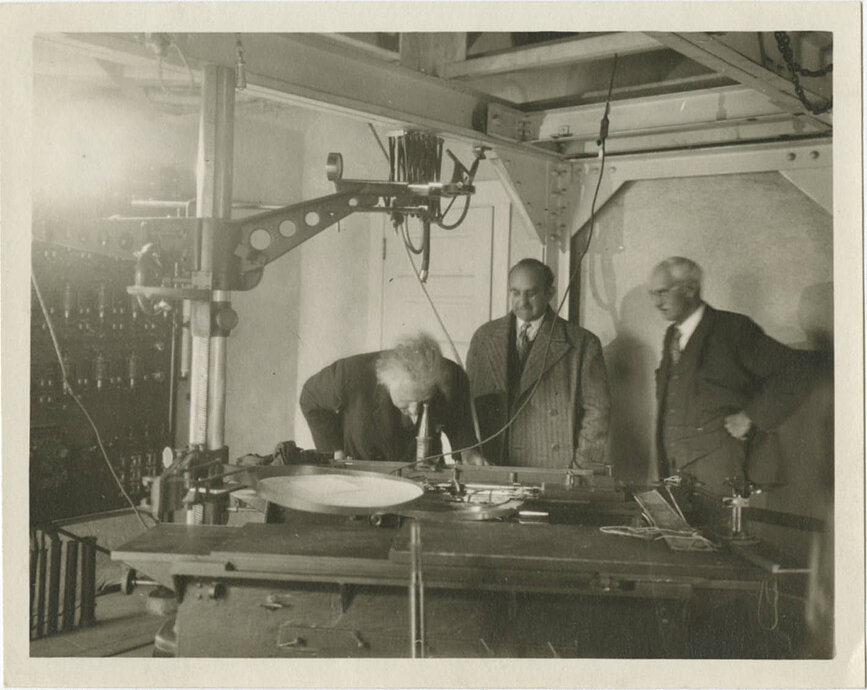Walther Mayer – More than “Einstein’s calculator”
22.03.2023
To physics posterity, Viennese mathematician Walther Mayer (1887-1948) is mostly known as “Einstein’s calculator”. He had apparently been called that at the California Institute of Technology in Pasadena, which Einstein and Mayer visited together in the winter of 1930/31. It is true that in order to advance in his studies to construct a unified field theory, Einstein relied on the expertise of mathematicians. With his unified field theory, Einstein attempted to formally join his own theory of general relativity with Maxwell’s electromagnetism.
When Einstein was looking for a new mathematics assistant in 1929, Mayer was hired on the recommendation of eminent mathematician Richard von Mises. Like Einstein, von Mises at that time held a professorship in Berlin. Walther Mayer then served as private lecturer at the University of Vienna, finishing the second volume of a very well received textbook series on differential geometry which he co-authored with fellow Viennese mathematician Adalbert Duschek. Subsequently, Mayer and Einstein worked together on several approaches towards a unified field theory consisting of 1) the analysis of solutions to Einstein’s so-called distant teleparallelism approach, 2) the invention of a variant of the Kaluza-Klein theory (in which not space-time, but attached vector spaces are 5-dimensional) and finally 3) the construction of a formalism they referred to as “semi-vectors” for interpreting Dirac-spinors in simpler, classical field-theoretical, terms and reformulating the Dirac equation accordingly. Their joint work was published in 7 papers over a period of roughly four years, 1930-1934.
According to Einstein, working with Mayer was an existential question (Lebensfrage). Seeking for continued funding for the collaboration with Mayer in Berlin, Einstein even sent a plea to Wilhelm Wirtinger. The “greatest Austrian mathematician”, as he was generally conceived of, was asked to exert his influence to the effect that Mayer would be given the title of professor from the University of Vienna. Wirtinger had already been Mayer’s doctoral advisor in 1912 and also supported his habilitation in 1926, in the face of strong political opposition - Mayer was Jewish. Moreso, Einstein and Wirtinger already knew each other personally and had corresponded about a way to generalize Riemannian geometry to obtain a unified field theory back in 1921. In any case, Einstein’s request was approved without great difficulties and Mayer was awarded an associate professorship (ausserordentlicher Universitätsprofessor) in 1931. Mayer immediately took a leave of absence from this position to continue his collaboration with Einstein in Berlin.
The mutual collaboration with Einstein was a Lebensfrage for Mayer as well as his position in Vienna was an unpaid one. The world economic crisis after the First World War resulted in a severely high unemployment rate amongst academics in Vienna.There were, in particular, only very few positions at universities. This led to relentless competition amongst the candidates and protectionist behavior of the authorities. Combined with an increasingly conservative and reactionary climate, Jewish researchers, such as Mayer, had little to no chance of making a career in Vienna. This was the case already years before the “Anschluss” of Austria to the German Reich in 1938. In October 1933, the year of Hitler’s assumption of power, Mayer and his wife were able to escape with the Einsteins to Princeton, where Einstein was offered a generous position.
While being humbly appreciative of the vital improvement that Einstein brought to his career, Mayer was at the same time also quite unhappy about his role as Einstein’s “appendage” (Anhängsel). Einstein, however, was aware of and respected this sentiment of Mayer’s: When he bargained his Princeton position with Abraham Flexner, a founding director of Princeton’s Institute for Advanced Study, he insisted on an independent professorship for Mayer as well. After some back and forth, this was indeed granted at the last minute. However, the question of Mayer's legitimacy as an independent professor at Princeton surfaced again after their arrival. Feeling unwelcomed and not sufficiently supported by Einstein, Mayer finally ended their collaboration after just one further joint paper in 1934. He felt that his career would be advanced best if from now on he would focus entirely on his own studies in pure mathematics. In the end, Mayer was able to retain his tenure at Princeton for the rest of his life, but he subsequently appeared to have wished to no longer be associated with work on unified field theory. On the outside, Einstein and Mayer remained in friendly contact while Einstein found new collaborators. The ones immediately succeeding Walther Mayer at Princeton were Boris Podolsky and Nathan Rosen.
To mathematics posterity, Walther Mayer is known as a namesake for the famous Mayer-Vietoris sequence in algebraic topology and for giving an early axiomatic treatment of homology, predating the Eilenberg–Steenrod axioms. His introduction of the modern notion of a chain complex is particularly noteworthy.
Bernadette Lessel would like to thank Christof Cappellaro and Georg Gaugusch for their invaluable help in identifying, retrieving and interpreting archival material related to Walther Mayer.

